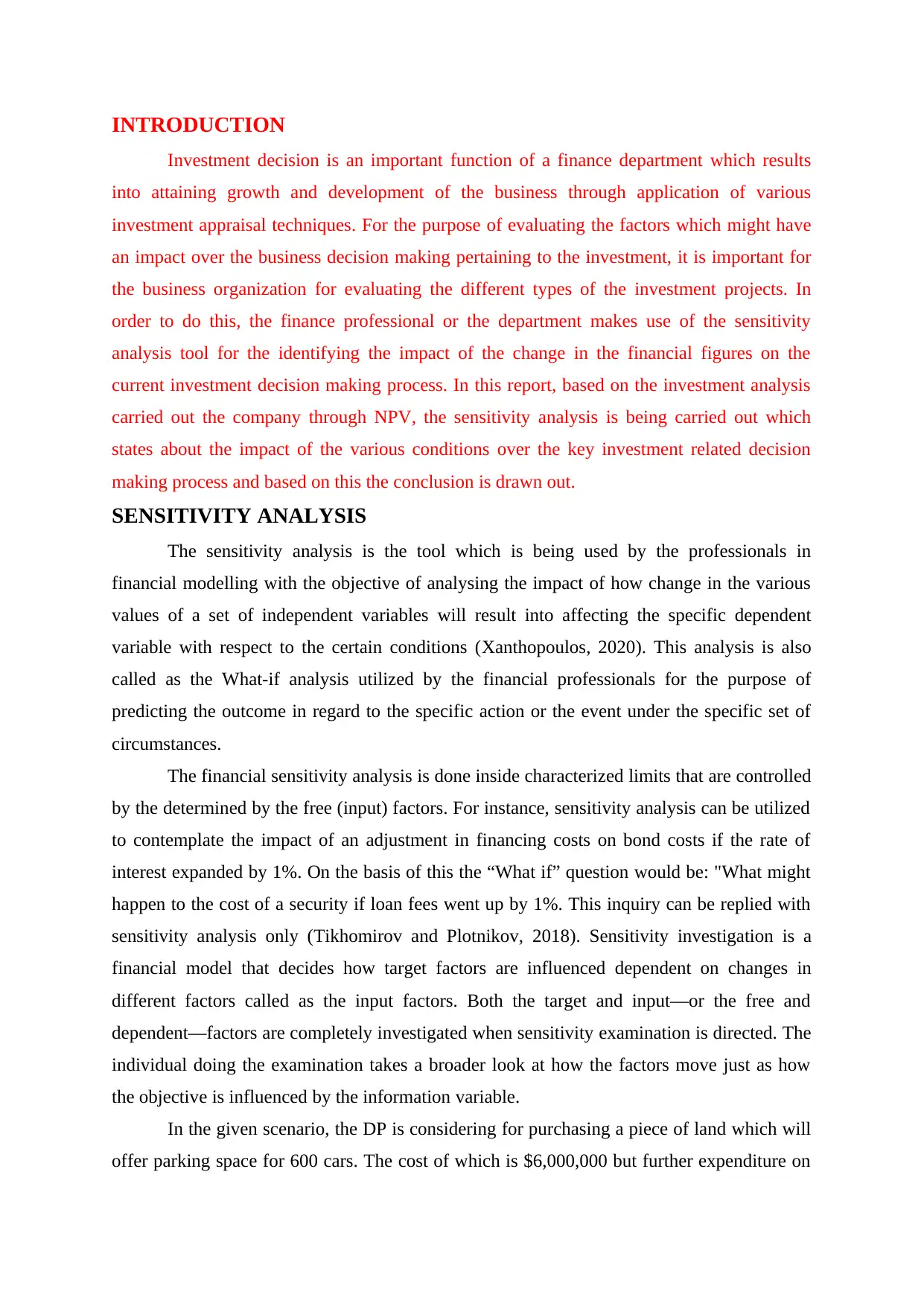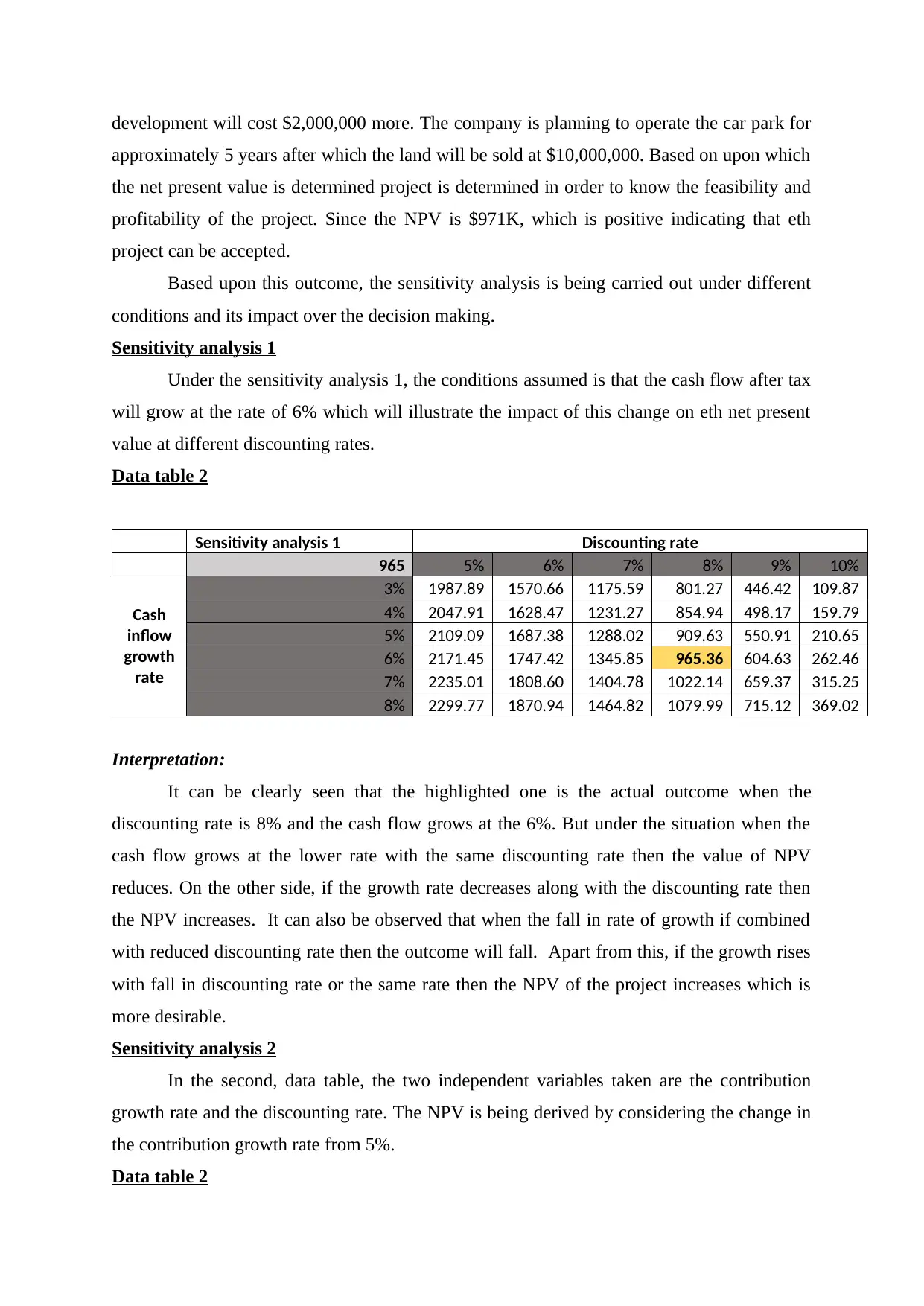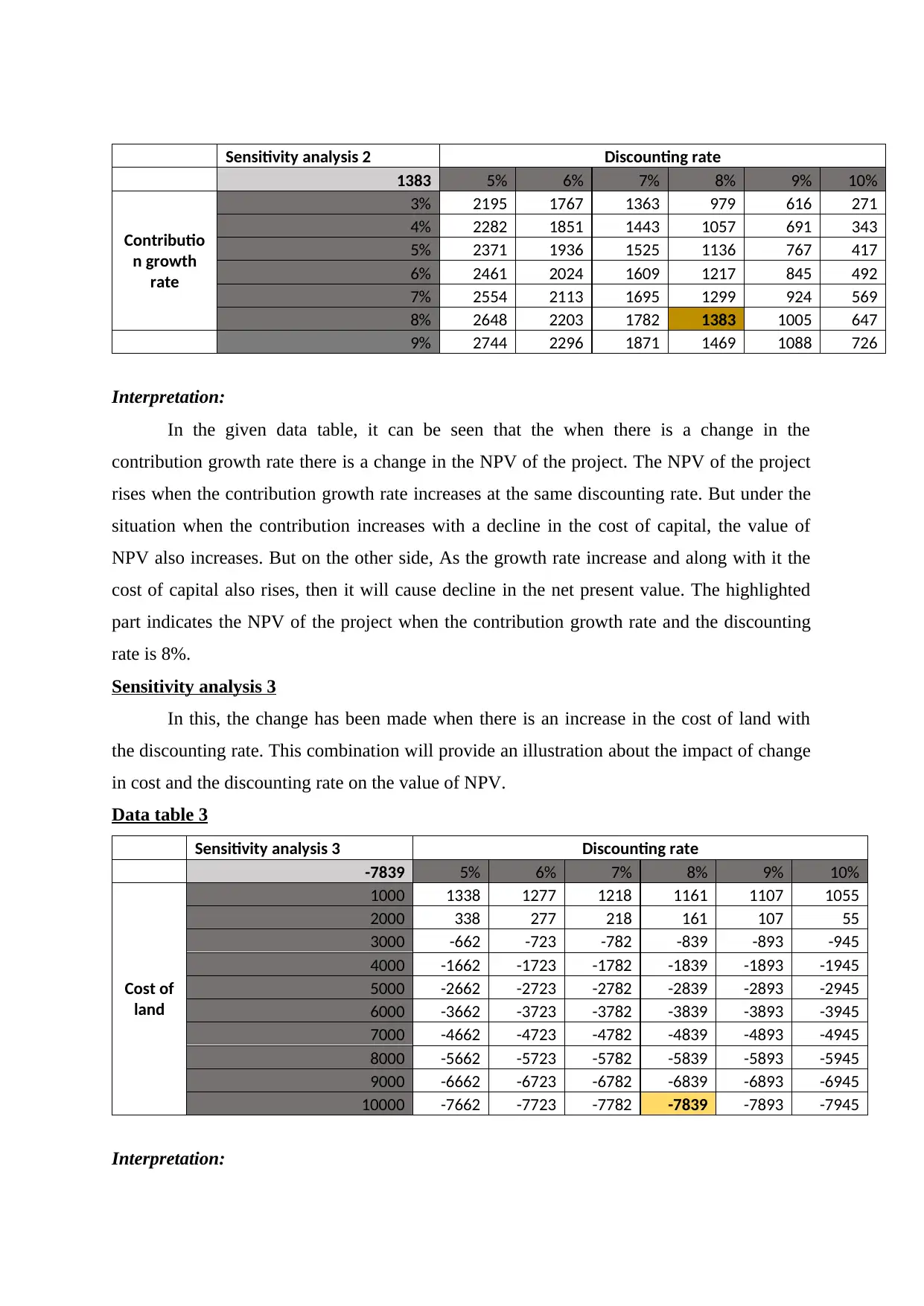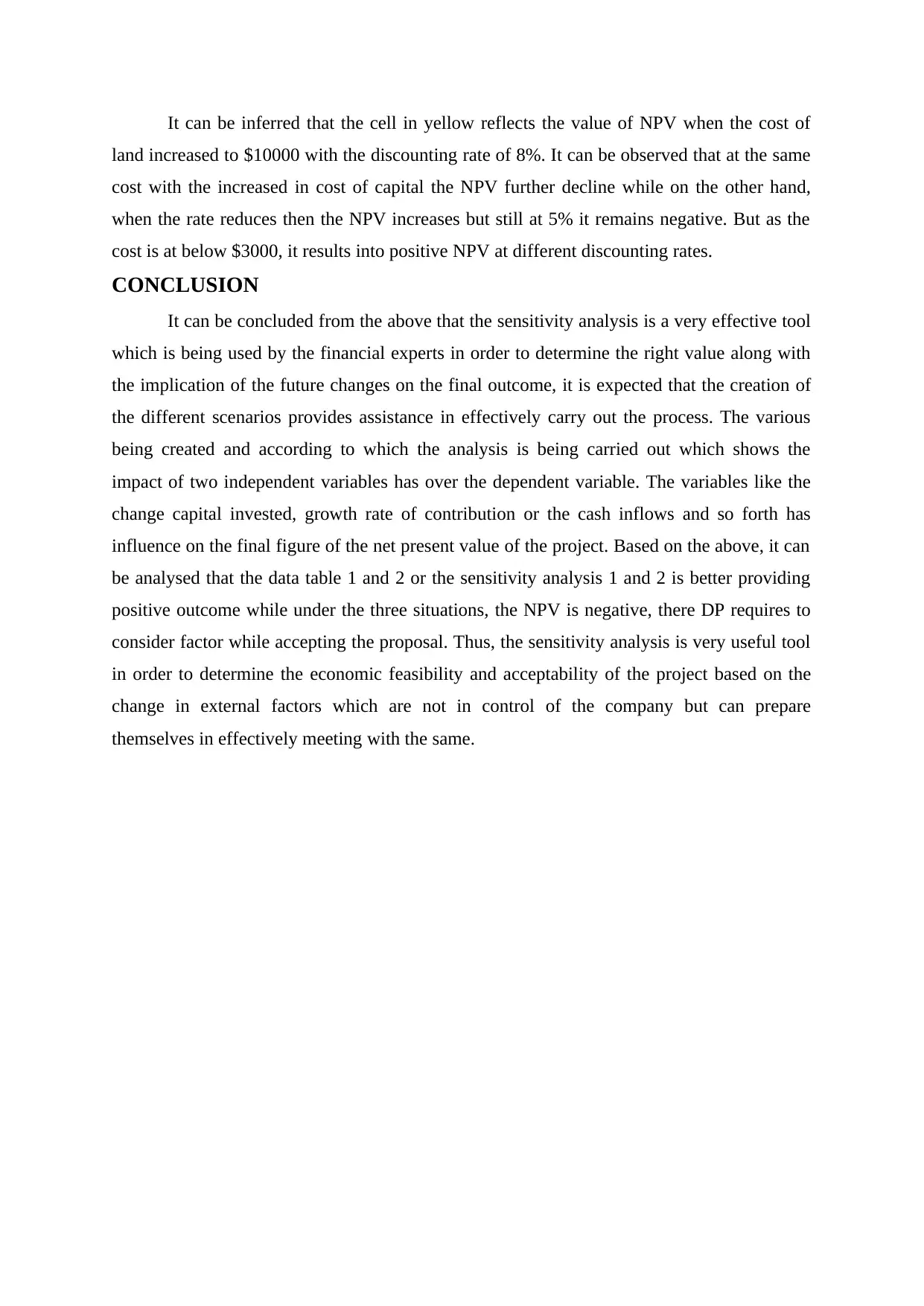Impact of Sensitivity Analysis on Investment Decisions: Report
VerifiedAdded on 2022/12/30
|7
|1618
|24
Report
AI Summary
This report delves into the application of sensitivity analysis within the context of financial investment decisions. It begins with an introduction to investment appraisal techniques and the crucial role of sensitivity analysis in evaluating the impact of various factors on investment outcomes. The report then presents a case study involving a company's decision to purchase land for a car park, using Net Present Value (NPV) to assess project feasibility. The core of the report comprises three sensitivity analyses, each examining how changes in key variables, such as cash flow growth rates, contribution growth rates, and the cost of land, influence the NPV. The analysis includes data tables illustrating the impact of these variables under different scenarios and provides interpretations to guide decision-making. The report concludes by highlighting the effectiveness of sensitivity analysis as a tool for financial professionals to determine the value and implications of future changes on the final investment outcome, thereby assisting in effectively carrying out the investment process. The report references relevant books and journals to support its findings.

Accounting and finance
Paraphrase This Document
Need a fresh take? Get an instant paraphrase of this document with our AI Paraphraser

Table of Contents
INTRODUCTION......................................................................................................................3
SENSITIVITY ANALYSIS.......................................................................................................3
CONCLUSION..........................................................................................................................6
REFERENCES...........................................................................................................................7
INTRODUCTION......................................................................................................................3
SENSITIVITY ANALYSIS.......................................................................................................3
CONCLUSION..........................................................................................................................6
REFERENCES...........................................................................................................................7

INTRODUCTION
Investment decision is an important function of a finance department which results
into attaining growth and development of the business through application of various
investment appraisal techniques. For the purpose of evaluating the factors which might have
an impact over the business decision making pertaining to the investment, it is important for
the business organization for evaluating the different types of the investment projects. In
order to do this, the finance professional or the department makes use of the sensitivity
analysis tool for the identifying the impact of the change in the financial figures on the
current investment decision making process. In this report, based on the investment analysis
carried out the company through NPV, the sensitivity analysis is being carried out which
states about the impact of the various conditions over the key investment related decision
making process and based on this the conclusion is drawn out.
SENSITIVITY ANALYSIS
The sensitivity analysis is the tool which is being used by the professionals in
financial modelling with the objective of analysing the impact of how change in the various
values of a set of independent variables will result into affecting the specific dependent
variable with respect to the certain conditions (Xanthopoulos, 2020). This analysis is also
called as the What-if analysis utilized by the financial professionals for the purpose of
predicting the outcome in regard to the specific action or the event under the specific set of
circumstances.
The financial sensitivity analysis is done inside characterized limits that are controlled
by the determined by the free (input) factors. For instance, sensitivity analysis can be utilized
to contemplate the impact of an adjustment in financing costs on bond costs if the rate of
interest expanded by 1%. On the basis of this the “What if” question would be: "What might
happen to the cost of a security if loan fees went up by 1%. This inquiry can be replied with
sensitivity analysis only (Tikhomirov and Plotnikov, 2018). Sensitivity investigation is a
financial model that decides how target factors are influenced dependent on changes in
different factors called as the input factors. Both the target and input—or the free and
dependent—factors are completely investigated when sensitivity examination is directed. The
individual doing the examination takes a broader look at how the factors move just as how
the objective is influenced by the information variable.
In the given scenario, the DP is considering for purchasing a piece of land which will
offer parking space for 600 cars. The cost of which is $6,000,000 but further expenditure on
Investment decision is an important function of a finance department which results
into attaining growth and development of the business through application of various
investment appraisal techniques. For the purpose of evaluating the factors which might have
an impact over the business decision making pertaining to the investment, it is important for
the business organization for evaluating the different types of the investment projects. In
order to do this, the finance professional or the department makes use of the sensitivity
analysis tool for the identifying the impact of the change in the financial figures on the
current investment decision making process. In this report, based on the investment analysis
carried out the company through NPV, the sensitivity analysis is being carried out which
states about the impact of the various conditions over the key investment related decision
making process and based on this the conclusion is drawn out.
SENSITIVITY ANALYSIS
The sensitivity analysis is the tool which is being used by the professionals in
financial modelling with the objective of analysing the impact of how change in the various
values of a set of independent variables will result into affecting the specific dependent
variable with respect to the certain conditions (Xanthopoulos, 2020). This analysis is also
called as the What-if analysis utilized by the financial professionals for the purpose of
predicting the outcome in regard to the specific action or the event under the specific set of
circumstances.
The financial sensitivity analysis is done inside characterized limits that are controlled
by the determined by the free (input) factors. For instance, sensitivity analysis can be utilized
to contemplate the impact of an adjustment in financing costs on bond costs if the rate of
interest expanded by 1%. On the basis of this the “What if” question would be: "What might
happen to the cost of a security if loan fees went up by 1%. This inquiry can be replied with
sensitivity analysis only (Tikhomirov and Plotnikov, 2018). Sensitivity investigation is a
financial model that decides how target factors are influenced dependent on changes in
different factors called as the input factors. Both the target and input—or the free and
dependent—factors are completely investigated when sensitivity examination is directed. The
individual doing the examination takes a broader look at how the factors move just as how
the objective is influenced by the information variable.
In the given scenario, the DP is considering for purchasing a piece of land which will
offer parking space for 600 cars. The cost of which is $6,000,000 but further expenditure on
⊘ This is a preview!⊘
Do you want full access?
Subscribe today to unlock all pages.

Trusted by 1+ million students worldwide

development will cost $2,000,000 more. The company is planning to operate the car park for
approximately 5 years after which the land will be sold at $10,000,000. Based on upon which
the net present value is determined project is determined in order to know the feasibility and
profitability of the project. Since the NPV is $971K, which is positive indicating that eth
project can be accepted.
Based upon this outcome, the sensitivity analysis is being carried out under different
conditions and its impact over the decision making.
Sensitivity analysis 1
Under the sensitivity analysis 1, the conditions assumed is that the cash flow after tax
will grow at the rate of 6% which will illustrate the impact of this change on eth net present
value at different discounting rates.
Data table 2
Sensitivity analysis 1 Discounting rate
965 5% 6% 7% 8% 9% 10%
Cash
inflow
growth
rate
3% 1987.89 1570.66 1175.59 801.27 446.42 109.87
4% 2047.91 1628.47 1231.27 854.94 498.17 159.79
5% 2109.09 1687.38 1288.02 909.63 550.91 210.65
6% 2171.45 1747.42 1345.85 965.36 604.63 262.46
7% 2235.01 1808.60 1404.78 1022.14 659.37 315.25
8% 2299.77 1870.94 1464.82 1079.99 715.12 369.02
Interpretation:
It can be clearly seen that the highlighted one is the actual outcome when the
discounting rate is 8% and the cash flow grows at the 6%. But under the situation when the
cash flow grows at the lower rate with the same discounting rate then the value of NPV
reduces. On the other side, if the growth rate decreases along with the discounting rate then
the NPV increases. It can also be observed that when the fall in rate of growth if combined
with reduced discounting rate then the outcome will fall. Apart from this, if the growth rises
with fall in discounting rate or the same rate then the NPV of the project increases which is
more desirable.
Sensitivity analysis 2
In the second, data table, the two independent variables taken are the contribution
growth rate and the discounting rate. The NPV is being derived by considering the change in
the contribution growth rate from 5%.
Data table 2
approximately 5 years after which the land will be sold at $10,000,000. Based on upon which
the net present value is determined project is determined in order to know the feasibility and
profitability of the project. Since the NPV is $971K, which is positive indicating that eth
project can be accepted.
Based upon this outcome, the sensitivity analysis is being carried out under different
conditions and its impact over the decision making.
Sensitivity analysis 1
Under the sensitivity analysis 1, the conditions assumed is that the cash flow after tax
will grow at the rate of 6% which will illustrate the impact of this change on eth net present
value at different discounting rates.
Data table 2
Sensitivity analysis 1 Discounting rate
965 5% 6% 7% 8% 9% 10%
Cash
inflow
growth
rate
3% 1987.89 1570.66 1175.59 801.27 446.42 109.87
4% 2047.91 1628.47 1231.27 854.94 498.17 159.79
5% 2109.09 1687.38 1288.02 909.63 550.91 210.65
6% 2171.45 1747.42 1345.85 965.36 604.63 262.46
7% 2235.01 1808.60 1404.78 1022.14 659.37 315.25
8% 2299.77 1870.94 1464.82 1079.99 715.12 369.02
Interpretation:
It can be clearly seen that the highlighted one is the actual outcome when the
discounting rate is 8% and the cash flow grows at the 6%. But under the situation when the
cash flow grows at the lower rate with the same discounting rate then the value of NPV
reduces. On the other side, if the growth rate decreases along with the discounting rate then
the NPV increases. It can also be observed that when the fall in rate of growth if combined
with reduced discounting rate then the outcome will fall. Apart from this, if the growth rises
with fall in discounting rate or the same rate then the NPV of the project increases which is
more desirable.
Sensitivity analysis 2
In the second, data table, the two independent variables taken are the contribution
growth rate and the discounting rate. The NPV is being derived by considering the change in
the contribution growth rate from 5%.
Data table 2
Paraphrase This Document
Need a fresh take? Get an instant paraphrase of this document with our AI Paraphraser

Sensitivity analysis 2 Discounting rate
1383 5% 6% 7% 8% 9% 10%
Contributio
n growth
rate
3% 2195 1767 1363 979 616 271
4% 2282 1851 1443 1057 691 343
5% 2371 1936 1525 1136 767 417
6% 2461 2024 1609 1217 845 492
7% 2554 2113 1695 1299 924 569
8% 2648 2203 1782 1383 1005 647
9% 2744 2296 1871 1469 1088 726
Interpretation:
In the given data table, it can be seen that the when there is a change in the
contribution growth rate there is a change in the NPV of the project. The NPV of the project
rises when the contribution growth rate increases at the same discounting rate. But under the
situation when the contribution increases with a decline in the cost of capital, the value of
NPV also increases. But on the other side, As the growth rate increase and along with it the
cost of capital also rises, then it will cause decline in the net present value. The highlighted
part indicates the NPV of the project when the contribution growth rate and the discounting
rate is 8%.
Sensitivity analysis 3
In this, the change has been made when there is an increase in the cost of land with
the discounting rate. This combination will provide an illustration about the impact of change
in cost and the discounting rate on the value of NPV.
Data table 3
Sensitivity analysis 3 Discounting rate
-7839 5% 6% 7% 8% 9% 10%
Cost of
land
1000 1338 1277 1218 1161 1107 1055
2000 338 277 218 161 107 55
3000 -662 -723 -782 -839 -893 -945
4000 -1662 -1723 -1782 -1839 -1893 -1945
5000 -2662 -2723 -2782 -2839 -2893 -2945
6000 -3662 -3723 -3782 -3839 -3893 -3945
7000 -4662 -4723 -4782 -4839 -4893 -4945
8000 -5662 -5723 -5782 -5839 -5893 -5945
9000 -6662 -6723 -6782 -6839 -6893 -6945
10000 -7662 -7723 -7782 -7839 -7893 -7945
Interpretation:
1383 5% 6% 7% 8% 9% 10%
Contributio
n growth
rate
3% 2195 1767 1363 979 616 271
4% 2282 1851 1443 1057 691 343
5% 2371 1936 1525 1136 767 417
6% 2461 2024 1609 1217 845 492
7% 2554 2113 1695 1299 924 569
8% 2648 2203 1782 1383 1005 647
9% 2744 2296 1871 1469 1088 726
Interpretation:
In the given data table, it can be seen that the when there is a change in the
contribution growth rate there is a change in the NPV of the project. The NPV of the project
rises when the contribution growth rate increases at the same discounting rate. But under the
situation when the contribution increases with a decline in the cost of capital, the value of
NPV also increases. But on the other side, As the growth rate increase and along with it the
cost of capital also rises, then it will cause decline in the net present value. The highlighted
part indicates the NPV of the project when the contribution growth rate and the discounting
rate is 8%.
Sensitivity analysis 3
In this, the change has been made when there is an increase in the cost of land with
the discounting rate. This combination will provide an illustration about the impact of change
in cost and the discounting rate on the value of NPV.
Data table 3
Sensitivity analysis 3 Discounting rate
-7839 5% 6% 7% 8% 9% 10%
Cost of
land
1000 1338 1277 1218 1161 1107 1055
2000 338 277 218 161 107 55
3000 -662 -723 -782 -839 -893 -945
4000 -1662 -1723 -1782 -1839 -1893 -1945
5000 -2662 -2723 -2782 -2839 -2893 -2945
6000 -3662 -3723 -3782 -3839 -3893 -3945
7000 -4662 -4723 -4782 -4839 -4893 -4945
8000 -5662 -5723 -5782 -5839 -5893 -5945
9000 -6662 -6723 -6782 -6839 -6893 -6945
10000 -7662 -7723 -7782 -7839 -7893 -7945
Interpretation:

It can be inferred that the cell in yellow reflects the value of NPV when the cost of
land increased to $10000 with the discounting rate of 8%. It can be observed that at the same
cost with the increased in cost of capital the NPV further decline while on the other hand,
when the rate reduces then the NPV increases but still at 5% it remains negative. But as the
cost is at below $3000, it results into positive NPV at different discounting rates.
CONCLUSION
It can be concluded from the above that the sensitivity analysis is a very effective tool
which is being used by the financial experts in order to determine the right value along with
the implication of the future changes on the final outcome, it is expected that the creation of
the different scenarios provides assistance in effectively carry out the process. The various
being created and according to which the analysis is being carried out which shows the
impact of two independent variables has over the dependent variable. The variables like the
change capital invested, growth rate of contribution or the cash inflows and so forth has
influence on the final figure of the net present value of the project. Based on the above, it can
be analysed that the data table 1 and 2 or the sensitivity analysis 1 and 2 is better providing
positive outcome while under the three situations, the NPV is negative, there DP requires to
consider factor while accepting the proposal. Thus, the sensitivity analysis is very useful tool
in order to determine the economic feasibility and acceptability of the project based on the
change in external factors which are not in control of the company but can prepare
themselves in effectively meeting with the same.
land increased to $10000 with the discounting rate of 8%. It can be observed that at the same
cost with the increased in cost of capital the NPV further decline while on the other hand,
when the rate reduces then the NPV increases but still at 5% it remains negative. But as the
cost is at below $3000, it results into positive NPV at different discounting rates.
CONCLUSION
It can be concluded from the above that the sensitivity analysis is a very effective tool
which is being used by the financial experts in order to determine the right value along with
the implication of the future changes on the final outcome, it is expected that the creation of
the different scenarios provides assistance in effectively carry out the process. The various
being created and according to which the analysis is being carried out which shows the
impact of two independent variables has over the dependent variable. The variables like the
change capital invested, growth rate of contribution or the cash inflows and so forth has
influence on the final figure of the net present value of the project. Based on the above, it can
be analysed that the data table 1 and 2 or the sensitivity analysis 1 and 2 is better providing
positive outcome while under the three situations, the NPV is negative, there DP requires to
consider factor while accepting the proposal. Thus, the sensitivity analysis is very useful tool
in order to determine the economic feasibility and acceptability of the project based on the
change in external factors which are not in control of the company but can prepare
themselves in effectively meeting with the same.
⊘ This is a preview!⊘
Do you want full access?
Subscribe today to unlock all pages.

Trusted by 1+ million students worldwide

REFERENCES
Books and Journals
Tikhomirov, D. and Plotnikov, V., 2018. The minimisation of risks in project finance:
approaches to financial modelling and structuring. In MATEC Web of
Conferences (Vol. 193, p. 05069). EDP Sciences.
Xanthopoulos, G., 2020. Viability modelling of seeds and sensitivity analysis under
fluctuating temperature and moisture content. Journal of Stored Products
Research. 89. p.101708.
Books and Journals
Tikhomirov, D. and Plotnikov, V., 2018. The minimisation of risks in project finance:
approaches to financial modelling and structuring. In MATEC Web of
Conferences (Vol. 193, p. 05069). EDP Sciences.
Xanthopoulos, G., 2020. Viability modelling of seeds and sensitivity analysis under
fluctuating temperature and moisture content. Journal of Stored Products
Research. 89. p.101708.
1 out of 7
Related Documents
Your All-in-One AI-Powered Toolkit for Academic Success.
+13062052269
info@desklib.com
Available 24*7 on WhatsApp / Email
![[object Object]](/_next/static/media/star-bottom.7253800d.svg)
Unlock your academic potential
Copyright © 2020–2025 A2Z Services. All Rights Reserved. Developed and managed by ZUCOL.





